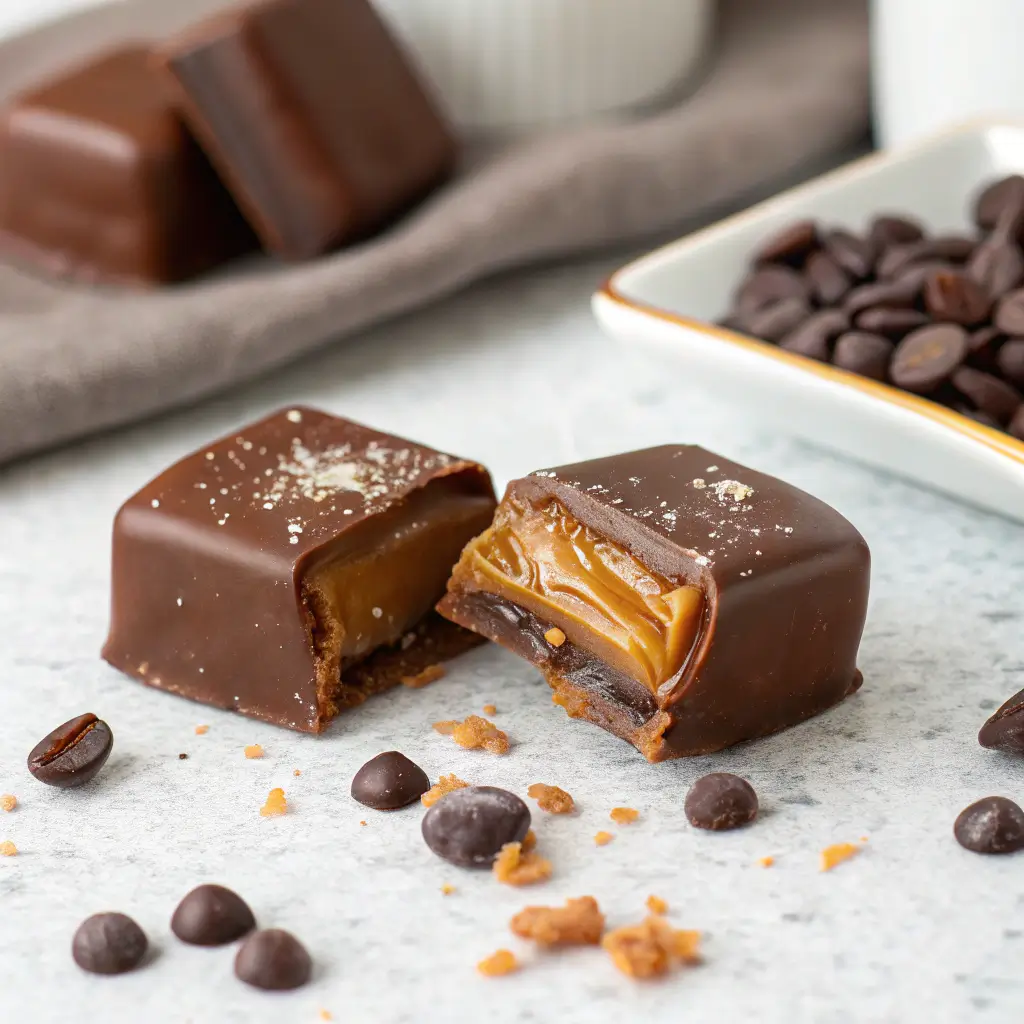The Ultimate Guide to Chocolate and Caramel Candy: Recipes, Tips, and Techniques
There’s something truly magical about the combination of chocolate and caramel candy that creates an irresistible harmony of flavors. The rich, velvety chocolate perfectly complements the sweet, buttery caramel, resulting in a decadent treat that satisfies even the most discerning sweet tooth. Moreover, making chocolate caramel candy at home allows you to customize the flavors, textures, and ingredients to create your perfect confection.

In this comprehensive guide, we’ll explore everything you need to know about chocolate and caramel candy, from basic recipes to advanced techniques. Whether you’re a novice candy maker or an experienced confectioner looking to expand your repertoire, this guide will help you master the art of creating delicious chocolate covered caramels that rival those from high-end chocolatiers.
Discovering the Perfect Chocolate and Caramel Candy Combination for Sweet Indulgence
The marriage of chocolate and caramel is one of the most beloved flavor combinations in the confectionery world. However, achieving the perfect balance requires understanding the nuances of both ingredients. The chocolate provides a firm, snappy exterior that gives way to a soft, chewy caramel center. Furthermore, the bitterness of dark chocolate or the creaminess of milk chocolate can be strategically paired with different caramel flavors to create a harmonious taste experience.
When creating chocolate caramel candy, it’s important to consider the texture of the caramel – whether you prefer a soft, flowing caramel or a firmer, chewier consistency. Additionally, the type of chocolate you choose will significantly impact the final result. Dark chocolate offers a more intense, slightly bitter flavor that contrasts beautifully with sweet caramel, while milk chocolate provides a smoother, more mellow taste that complements the buttery notes of the caramel.
Essential Ingredients and Equipment for Homemade Chocolate Caramel Candy Making
Before diving into recipes, it’s crucial to gather the right ingredients and tools. To create successful chocolate and caramel candy, you’ll need:
High-Quality Ingredients for Delicious Homemade Caramel and Chocolate Candy Creations
- Sugar: The foundation of any caramel recipe, sugar transforms through caramelization to create that distinctive flavor.
- Heavy cream or heavy whipping cream: This adds richness and creaminess to your caramel mixture.
- Butter: Preferably unsalted butter for control over the final salt content.
- Corn syrup: This helps prevent crystallization and creates a smoother caramel texture.
- Salt: Sea salt or kosher salt enhances the flavor. For salted caramel variations, you might want to add extra.
- Vanilla extract: Adds depth and warmth to the caramel flavor.
- Chocolate: Choose high-quality chocolate – milk chocolate, dark chocolate, or white chocolate depending on your preference.
- Additional flavorings: Optional ingredients like espresso powder, spices, or liqueurs can infuse unique flavors.
Essential Tools for Perfect Chocolate Covered Caramel Preparation
- Candy thermometer: A reliable thermometer is absolutely essential for achieving the correct temperature for your caramel.
- Heavy-bottomed saucepan: A good quality saucepan that distributes heat evenly is crucial for caramel making.
- Silicone spatula: Heat-resistant spatulas are perfect for stirring the hot caramel mixture.
- Parchment paper: Essential for lining pans and preventing sticking.
- Baking sheet or loaf pan: For setting your caramel before cutting.
- Sharp knife: For cutting the caramel into neat pieces.
- Double boiler: Optional but useful for melting chocolate gently.
For more information on selecting the best chocolate for candy making, check out this guide from the International Chocolate Awards.
Basic Chocolate Caramel Candy Recipe for Beginners to Master
Let’s start with a foundational recipe that serves as an excellent introduction to making chocolate caramel candy at home. This recipe produces soft, chewy caramels enrobed in rich chocolate.
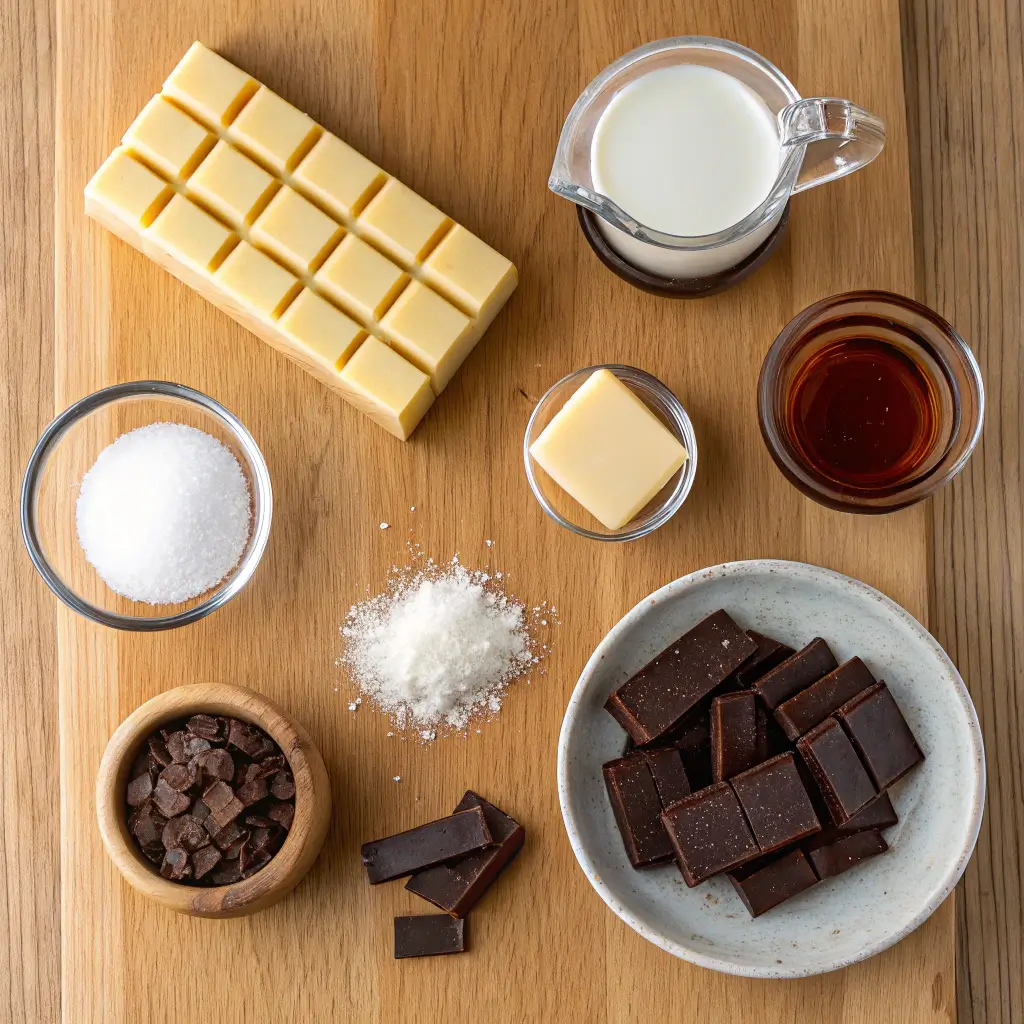
Simple Homemade Caramel Recipe with Perfect Chocolate Coating Technique
Ingredients:
- 1 cup granulated sugar
- 1/2 cup corn syrup
- 1 cup heavy whipping cream, divided
- 4 tablespoons unsalted butter
- 1/2 teaspoon sea salt
- 1 teaspoon vanilla extract
- 8 ounces good quality chocolate (milk, dark, or a combination)
For the Caramel:
- Line an 8-inch square pan with parchment paper, leaving some overhang for easy removal later.
- In a medium heavy-bottomed saucepan, combine sugar, corn syrup, and 1/2 cup of the heavy cream. Stir until the sugar dissolves.
- Place over medium heat and cook without stirring until the mixture reaches 240°F (soft ball stage) on a candy thermometer.
- Meanwhile, heat the remaining 1/2 cup of heavy cream in a small saucepan until warm but not boiling.
- Once the sugar mixture reaches 240°F, carefully add the warm cream (the mixture will bubble vigorously), butter, and salt.
- Continue cooking, stirring occasionally, until the caramel reaches 245°F for soft caramels or 248°F for firmer caramels.
- Remove from heat and stir in the vanilla extract.
- Pour the caramel mixture into the prepared pan and let it cool completely at room temperature (about 2 hours) or refrigerate for faster setting.
For the Chocolate Coating:
- Once the caramel is set, lift it out of the pan using the parchment paper overhang.
- With a sharp knife, cut the caramel into 1-inch squares or rectangles.
- Melt the chocolate using a double boiler or in the microwave in short 20-second bursts, stirring between each burst.
- Dip each caramel piece into the melted chocolate, allowing excess chocolate to drip off.
- Place the chocolate covered caramels on a parchment-lined baking sheet.
- For a finishing touch, sprinkle with a tiny amount of sea salt before the chocolate sets, if desired.
- Allow the chocolate to set completely before serving or storing.
Troubleshooting Common Issues When Making Chocolate and Caramel Candy
Even experienced confectioners encounter challenges when making caramel. Here are some common issues and how to solve them:
- Grainy caramel: This happens when sugar crystals form. To prevent this, avoid stirring the mixture during the initial cooking phase and use corn syrup.
- Burnt caramel: Cooking at too high a temperature can lead to burning. Use a heavy-bottomed saucepan and moderate heat.
- Caramel too soft: If your caramel doesn’t set properly, you likely didn’t reach a high enough temperature. Always use a candy thermometer for accuracy.
- Caramel too hard: Conversely, cooking to too high a temperature results in hard caramel. Remember that caramel continues to cook slightly after removing from heat.
- Chocolate seizing: This occurs when moisture gets into the melted chocolate. Ensure all utensils are completely dry before they touch the chocolate.
- Chocolate blooming: White streaks in set chocolate usually indicate improper tempering. While this doesn’t affect taste, proper tempering techniques can prevent this issue.
The Spruce Eats offers excellent solutions for common candy-making problems.
Advanced Chocolate Caramel Candy Recipes for Experienced Confectioners
Once you’ve mastered the basics, you can move on to more sophisticated recipes that incorporate additional flavors and techniques.
Salted Caramel Dark Chocolate Truffles with Homemade Caramel Filling
This recipe elevates the classic chocolate and caramel combination with a luxurious truffle format.
Ingredients:
- 1 cup sugar
- 1/4 cup water
- 1/2 cup heavy cream, warmed
- 3 tablespoons unsalted butter
- 1 teaspoon vanilla extract
- 1/2 teaspoon sea salt, plus extra for sprinkling
- 12 ounces high-quality dark chocolate, divided
- 2 tablespoons cocoa powder for dusting
Method:
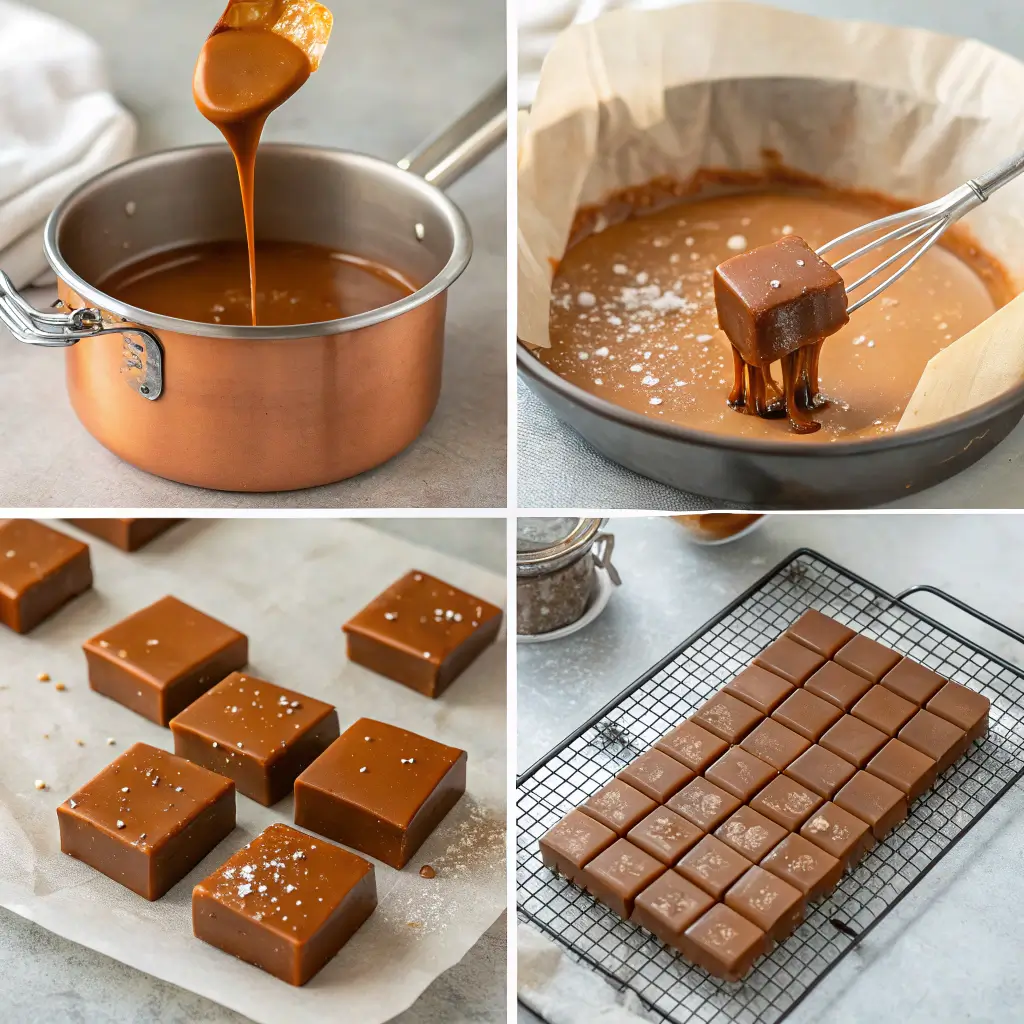
- In a heavy-bottomed saucepan, combine sugar and water. Cook over medium heat without stirring until the mixture turns an amber color.
- Carefully add the warm heavy cream (the mixture will bubble vigorously), then the butter and salt.
- Cook, stirring constantly, until the mixture reaches 240°F on a candy thermometer.
- Remove from heat, stir in vanilla, and let cool until thick but still pourable.
- Melt 4 ounces of chocolate and spread a thin layer on a parchment-lined baking sheet. Let it set partially.
- Drop small spoonfuls of the caramel onto the chocolate base, leaving space between each.
- Let the caramel set completely.
- Melt the remaining 8 ounces of chocolate and cover each caramel mound with chocolate to form truffles.
- Before the chocolate sets completely, sprinkle with a tiny amount of sea salt.
- Dust with cocoa powder if desired.
Chocolate Covered Caramel Candy with Infused Flavors and Gourmet Additions
Adding unique flavors to your chocolate caramel candy can create signature confections that stand out from store-bought varieties.
Espresso Caramel in Dark Chocolate:
- Add 1 tablespoon of espresso powder to the caramel mixture after removing from heat.
Orange-Infused Caramel in White Chocolate:
- Add orange zest to the heavy cream and let it infuse for 30 minutes before straining and using in the recipe.
Spiced Caramel in Milk Chocolate:
- Add 1/4 teaspoon each of cinnamon, nutmeg, and cardamom to the caramel mixture.
Bourbon Caramel in Dark Chocolate:
- Add 2 tablespoons of bourbon to the caramel after removing from heat.
Storing and Preserving Homemade Chocolate and Caramel Candy for Optimal Freshness
Proper storage is crucial for maintaining the quality of your homemade chocolate caramel candy.
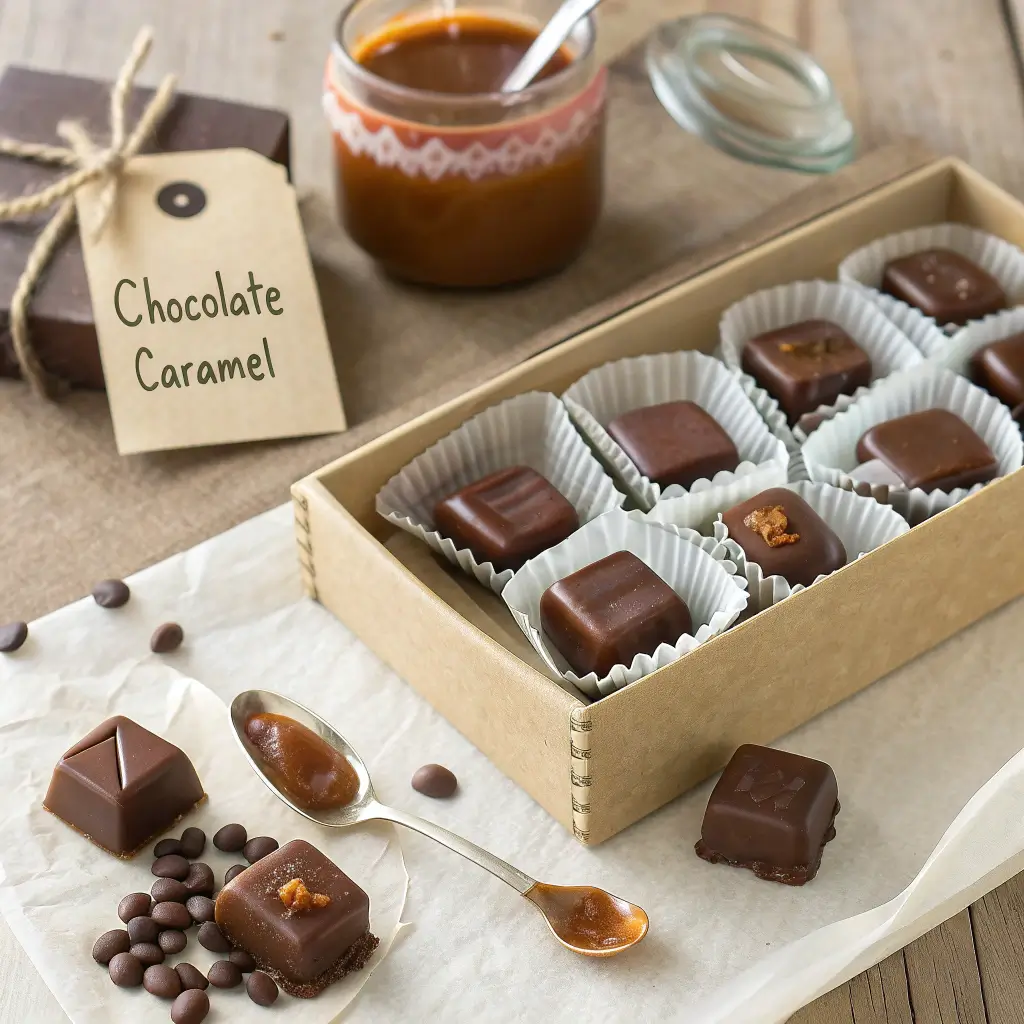
Best Practices for Keeping Chocolate Covered Caramels Fresh and Delicious
- Temperature: Store in a cool, dry place at around 60-70°F (15-21°C). Avoid refrigeration as it can cause condensation and sugar bloom.
- Packaging: Wrap individual pieces in wax paper or parchment paper to prevent sticking.
- Containers: After wrapping, store in an airtight container to maintain freshness.
- Shelf Life: Properly stored homemade chocolate caramel candy typically lasts 2-3 weeks at room temperature.
- Freezing: For longer storage, you can freeze unwrapped caramels for up to 3 months. Thaw at room temperature before coating with chocolate.
Chocolate and Caramel Candy Pairing Guide for Enhanced Flavor Experiences
The right pairing can elevate your chocolate caramel candy experience to new heights.
Complementary Flavors and Beverages That Enhance Chocolate and Caramel Treats
- Coffee: The bitterness of coffee beautifully complements the sweetness of caramel and chocolate.
- Red Wine: Particularly full-bodied varieties like Cabernet Sauvignon pair well with dark chocolate caramels.
- Bourbon or Whiskey: The caramel notes in these spirits naturally enhance caramel candies.
- Sea Salt: A sprinkle of flaky sea salt on chocolate caramel creates a delightful contrast.
- Nuts: Toasted pecans, almonds, or hazelnuts add texture and complement both chocolate and caramel flavors.
- Dried Fruits: Cherries or cranberries offer a tart contrast to the sweet caramel.
Creative Variations on Traditional Chocolate and Caramel Candy Recipes
Don’t be afraid to experiment with your chocolate caramel candy recipes to create unique treats.
Innovative Chocolate Caramel Candy Recipes with Unexpected Ingredients
Chocolate Caramel Pretzel Bars:
- Pour the caramel over a layer of pretzels before covering with chocolate for a sweet and salty crunch.
Chocolate Caramel Candy with Coconut:
- Roll the caramel in toasted coconut before dipping in chocolate.
Layered Chocolate Caramel Candy:
- Create alternating layers of different types of chocolate and caramel for a visually striking and complex treat.
Chocolate Caramel Candy with Nuts:
- Incorporate toasted nuts into the caramel or sprinkle them on top of the chocolate for added texture.
If you enjoy the combination of caramel with other treats, you might love our Rice Cakes Caramel: Easy Sweet Snack recipe that transforms simple rice cakes into delightful caramel-topped treats.
Gifting and Presenting Homemade Chocolate Caramel Candy Creations
Homemade chocolate caramel candy makes an excellent gift for various occasions.
Beautiful Packaging Ideas for Sharing Your Homemade Chocolate and Caramel Delights
- Decorative Boxes: Line small gift boxes with parchment paper and arrange your candies inside.
- Glass Jars: Layer wrapped caramels in clear glass jars tied with ribbon.
- Cellophane Bags: Place a few pieces in clear bags tied with decorative ribbon.
- Custom Labels: Create personalized labels with the flavor, ingredients, and your name.
- Seasonal Themes: Adapt your packaging to holidays or special occasions.
Understanding the Science Behind Chocolate and Caramel Candy Making
Knowing the science behind candy making can help you achieve consistent results and troubleshoot issues.
Chemical Reactions and Temperatures in Caramel and Chocolate Processing
Caramelization:
- Caramelization occurs when sugar molecules break down at high temperatures (around 320°F).
- This process creates hundreds of new compounds that give caramel its characteristic flavor and color.
Maillard Reaction:
- This reaction between amino acids and reducing sugars gives caramel its brown color and complex flavor.
- It’s enhanced by the addition of dairy products like cream and butter.
Chocolate Tempering:
- Tempering involves carefully controlling the temperature of melted chocolate to ensure proper crystallization of cocoa butter.
- Well-tempered chocolate has a shiny appearance, snaps cleanly, and doesn’t bloom.
Temperature Stages in Candy Making:
- Thread Stage: 230-235°F
- Soft Ball Stage: 235-240°F (ideal for soft caramels)
- Firm Ball Stage: 245-250°F (ideal for chewy caramels)
- Hard Ball Stage: 250-265°F (for harder caramels)
Health-Conscious Alternatives for Chocolate and Caramel Candy Lovers
For those with dietary restrictions or preferences, there are several ways to adapt traditional chocolate caramel candy recipes.
Dietary-Friendly Chocolate Caramel Candy Recipes for Various Preferences
Vegan Chocolate Caramel Candy:
- Replace heavy cream with full-fat coconut milk
- Use coconut oil instead of butter
- Choose dairy-free dark chocolate
Reduced Sugar Chocolate Caramel Candy:
- Use alternative sweeteners like allulose or erythritol (note that these behave differently than sugar)
- Opt for darker chocolate with higher cocoa content
- Emphasize salt and vanilla to enhance sweetness perception
Gluten-Free Considerations:
- Traditional caramel is naturally gluten-free
- Verify that all ingredients, particularly flavorings and chocolate, are certified gluten-free
Discover sugar alternatives for caramel making at All Recipes’ sugar substitution guide.Troubleshooting
Seasonal and Holiday Chocolate Caramel Candy Variations
Adapt your chocolate caramel candy recipes to celebrate different times of the year.
Festive Chocolate and Caramel Treats for Special Occasions
Valentine’s Day:
- Shape caramels into hearts before coating with chocolate
- Add a touch of red food coloring to white chocolate for a romantic drizzle
Halloween:
- Add orange food coloring to caramel and shape into spooky forms
- Decorate with edible eyes or Halloween-themed sprinkles
Christmas:
- Infuse caramel with peppermint, cinnamon, or nutmeg
- Sprinkle with crushed candy canes before the chocolate sets
Summer Treats:
- Incorporate tropical flavors like coconut or mango
- Pair with fresh berries for a seasonal twist
Frequently Asked Questions About Chocolate and Caramel Candy
Can you mix chocolate and caramel together?
Absolutely! In fact, mixing chocolate directly into caramel creates a delicious confection called “chocolate caramel.” To do this, add finely chopped chocolate or chocolate chips to the caramel mixture after removing it from heat. The residual heat will melt the chocolate, creating a marbled effect or a uniform chocolate caramel depending on how much you stir it. This technique results in a richer flavor profile and slightly firmer texture than traditional caramel.
Why are chocolate and caramel called turtles?
Chocolate and caramel candies known as “turtles” earned their name from their distinctive appearance. The original turtle candy consists of a pecan cluster covered with caramel and then coated in chocolate. When viewed from above, the resulting candy resembles a turtle with a caramel body and pecan “legs” peeking out from under the chocolate shell. This classic confection was first created by Johnson’s Candy Company (later DeMet’s Candy Company) in 1918 and has remained popular for over a century.
What was the first candy bar to combine chocolate, marshmallows, peanuts, and caramel?
The Goo Goo Cluster, created in 1912 by the Standard Candy Company in Nashville, Tennessee, is widely recognized as the first candy bar to combine chocolate, marshmallows, peanuts, and caramel in a single confection. This innovative combination was revolutionary at the time, as most candy bars featured only one or two primary ingredients. The Goo Goo Cluster is considered one of America’s oldest combination candy bars and helped pave the way for the complex, multi-layered candy bars we enjoy today.
Does chocolate taste good with caramel?
Chocolate and caramel are considered one of the most harmonious flavor pairings in confectionery. The bitter, complex notes of chocolate perfectly complement the sweet, buttery richness of caramel, creating a balanced flavor profile that appeals to many palates. The textural contrast between smooth, firm chocolate and soft, chewy caramel also enhances the eating experience. This is why chocolate and caramel remain one of the most popular candy combinations worldwide.
Does chocolate with caramel go bad?
Chocolate caramel candy does eventually go bad, but with proper storage, it can last quite a while. Homemade chocolate covered caramels typically maintain best quality for 2-3 weeks when stored in an airtight container at room temperature. Signs that chocolate caramel candy has gone bad include an off smell, unusual texture changes, or the development of mold. The high sugar content in caramel acts as a natural preservative, extending shelf life, but the dairy components (butter and cream) can eventually spoil.
What is a good combination with caramel?
Beyond chocolate, caramel pairs beautifully with numerous flavors and ingredients. Some exceptional combinations include:
- Sea salt (creates the popular salted caramel)
- Coffee or espresso (enhances caramel’s depth)
- Vanilla (adds warmth and complexity)
- Nuts like pecans, almonds, or hazelnuts (provides textural contrast)
- Bourbon or whiskey (complements the buttery notes)
- Apple (a classic pairing in desserts)
- Banana (creates a rich, tropical flavor)
- Coconut (adds exotic notes)
- Cinnamon or other warm spices (enhances depth)
Caramel also pairs wonderfully with whole grains, as demonstrated in our popular Caramel Corn Rice Cakes: Whole-Grain Brown Rice recipe.
What is gopher candy?
Gopher candy is a regional variation of turtle candy, particularly popular in parts of the Midwest. Similar to turtles, gopher candy consists of a cluster of nuts (typically pecans) covered with caramel and enrobed in chocolate. The name “gopher” likely comes from the appearance of the nuts peeking out from under the chocolate, resembling a gopher peeking out of its burrow. Despite the different name, the composition and preparation are nearly identical to traditional turtle candy.
What nut is in a turtle candy?
Traditional turtle candy features pecans as the standard nut component. The original recipe calls for arranging three to five pecan halves in a star pattern before covering them with caramel and chocolate. The pecans not only add a delicious nutty flavor but also provide the crucial visual element that gives turtles their name, as they resemble turtle legs extending from under a shell. While variations exist using other nuts like cashews, almonds, or walnuts, authentic turtle candy is made with pecans.
Who made the original turtle candy?
The original turtle candy was created by Johnson’s Candy Company (which later became DeMet’s Candy Company) in 1918. According to company lore, a dipping room worker showed a new candy creation to one of the owners, remarking that it looked like a turtle. The name stuck, and “turtles” became one of the company’s signature products. DeMet’s eventually trademarked the name “Turtles” for their specific product, which is why similar candies from other manufacturers often have different names.
What to do with a jar of salted caramel?
A jar of salted caramel sauce offers numerous delicious possibilities:
- Drizzle over ice cream, cheesecake, or brownies
- Use as a filling for homemade chocolates or truffles
- Swirl into brownie or blondie batter before baking
- Spread between cake layers
- Mix into coffee or hot chocolate
- Fold into whipped cream for a caramel mousse
- Use as a dip for apple slices or pretzels
- Incorporate into buttercream frosting
- Drizzle over popcorn for a sweet treat
- Add to breakfast items like pancakes, waffles, or oatmeal
What is the Starbucks drink with caramel?
Starbucks offers several popular caramel-flavored drinks, with the Caramel Macchiato being perhaps the most iconic. This beverage features espresso poured over steamed milk marked with vanilla syrup and topped with caramel drizzle. Other caramel offerings include the Caramel Frappuccino (a blended ice beverage), Caramel Ribbon Crunch Frappuccino (featuring caramel sauce, whipped cream, and a crunchy caramel sugar topping), and various seasonal offerings that incorporate caramel flavors.
What are the three types of caramel?
The three main types of caramel are:
- Wet Caramel: Made by combining sugar with water before heating. This method provides more control and is more forgiving for beginners, as the water helps the sugar dissolve and caramelize more evenly.
- Dry Caramel: Created by heating sugar alone without any added water. This technique yields a deeper flavor but requires more skill to prevent burning.
- Caramel Sauce: A softer, pourable caramel made by adding cream, butter, and sometimes vanilla after caramelizing sugar. This versatile form of caramel is used for drizzling and as an ingredient in various desserts.
Additionally, there are specialty variations like salted caramel (with added salt) and caramel candies (cooked to specific temperatures for different textures).
Elevating Your Homemade Chocolate Caramel Candy with Professional Techniques
To create truly exceptional chocolate caramel candy, consider incorporating these professional techniques into your process.
Advanced Chocolate Tempering Methods for Glossy Chocolate Covered Caramels
Properly tempered chocolate is the secret to professional-looking chocolate caramel candy. The tempering process ensures that cocoa butter crystallizes in a stable form, resulting in a shiny finish and clean snap.
Seeding Method for Tempering Chocolate:
- Melt two-thirds of your chocolate to 115°F for dark chocolate or 110°F for milk or white chocolate.
- Remove from heat and add the remaining one-third of finely chopped chocolate.
- Stir constantly until the temperature drops to 82-84°F for dark chocolate or 80-82°F for milk or white chocolate.
- Gently rewarm to 88-90°F for dark chocolate or 86-88°F for milk or white chocolate.
- Test by spreading a small amount on parchment paper – properly tempered chocolate will set quickly with a shine.
Properly tempered chocolate not only looks more professional but also helps preserve your chocolate caramel candy longer by creating a protective shell around the caramel filling.
Artisanal Decorating Techniques for Stunning Chocolate and Caramel Presentation
Elevate the appearance of your chocolate caramel candy with these decorative techniques:
Marbling:
- Drizzle a contrasting chocolate (white on dark or vice versa) over freshly dipped caramels.
- Use a toothpick to create swirl patterns before the chocolate sets.
Transfer Sheets:
- Place chocolate transfer sheets pattern-side up on a baking sheet.
- Pour tempered chocolate over the sheet and spread evenly.
- Place caramel pieces on the chocolate while still warm.
- Cover with more tempered chocolate.
- Once set, peel away the transfer sheet to reveal the pattern.
Hand-Dipping vs. Enrobing:
- For a rustic, artisanal look, hand-dip caramels using a dipping fork.
- For a more uniform appearance, create a simple enrobing setup by placing caramels on a wire rack and pouring tempered chocolate over them.
Exploring Regional and International Chocolate and Caramel Candy Traditions
Different cultures around the world have their own unique takes on chocolate and caramel confections.
Global Variations of Chocolate Caramel Candy from Different Culinary Traditions
French Caramels:
- French caramels often incorporate heavy cream and butter for a rich, smooth texture.
- Fleur de sel caramels (caramel au beurre salé) feature sea salt harvested from the coast of Brittany.
British Toffee:
- Similar to caramel but cooked longer for a harder texture.
- Often sandwiched between layers of chocolate.
Mexican Cajeta:
- A goat’s milk caramel with a distinctive tangy flavor.
- Frequently paired with cinnamon and dark chocolate.
Japanese Nama Chocolate:
- Soft, ganache-like chocolate that pairs beautifully with caramel layers.
- Known for precise, geometric shapes and minimal decoration.
Incorporating Chocolate and Caramel Candy into Desserts and Other Recipes
Your homemade chocolate caramel candy can serve as an ingredient or component in countless other treats.
Creative Ways to Use Homemade Chocolate Caramel Candy in Baking and Desserts
Chocolate Caramel Brownie Topping:
- Chop chocolate caramel candy into small pieces and fold into brownie batter.
- Alternatively, melt and swirl into the batter before baking.
Chocolate Caramel Cheesecake:
- Create a layer of caramel between the crust and cheesecake filling.
- Top with chopped chocolate caramel candy pieces.
Caramel Chocolate Ice Cream Mix-In:
- Fold small pieces of chocolate caramel candy into softened vanilla ice cream.
- Refreeze until firm.
Chocolate Caramel Bread Pudding:
- Layer pieces of chocolate caramel candy between bread cubes.
- Pour custard mixture over and bake until set.
Chocolate Caramel Tart:
- Fill a pre-baked tart shell with caramel.
- Top with a layer of ganache and decorative chocolate work.
Scaling Your Chocolate Caramel Candy Production: From Home Kitchen to Small Batch
If you’re interested in scaling up your chocolate caramel candy production, consider these tips.
Tips for Efficiently Producing Larger Quantities of Homemade Chocolate and Caramel Treats
- Invest in Larger Equipment:
- A larger heavy-bottomed pot allows for bigger batches of caramel.
- Consider a confectionery guitar (a frame with wire cutters) for uniform cutting.
- Work in Stages:
- Prepare caramel one day, then dip in chocolate the next.
- Create an assembly line if working with helpers.
- Maintain Temperature Control:
- Keep melted chocolate at proper working temperature using a warming tray.
- Use a water bath to slowly warm caramel if it becomes too firm.
- Packaging Efficiency:
- Pre-cut parchment wrappers before beginning the wrapping process.
- Use molds for consistent shapes that are easier to package.
- Quality Control:
- Implement a system to check that each piece meets your standards.
- Track batch numbers if selling commercially.
Conclusion: Mastering the Art of Chocolate and Caramel Candy Making
Creating chocolate caramel candy at home is both a science and an art. With practice, patience, and attention to detail, you can create confections that rival or surpass those from high-end chocolatiers. The combination of rich chocolate and buttery caramel offers endless possibilities for customization and creativity.
Whether you’re making these treats for personal enjoyment, to share with loved ones, or even to start a small business, the techniques and recipes in this guide provide a solid foundation for your chocolate caramel candy journey. Remember that each batch is an opportunity to refine your skills and explore new flavor combinations.
The most important ingredients in exceptional chocolate caramel candy are quality components and passion for the craft. With these in abundance, your homemade confections will delight everyone fortunate enough to taste them. So gather your ingredients, calibrate your candy thermometer, and embark on the rewarding adventure of chocolate and caramel candy making.
Explore international caramel traditions at Saveur’s global candy collection.
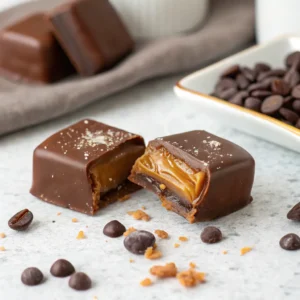
Salted Dark Chocolate Caramels
Equipment
- 1 8×8-inch baking pan
- 1 Sheet of parchment paper
- 1 Heavy-bottomed medium saucepan
- 1 Candy thermometer
- 1 Heatproof silicone spatula
- 1 Sharp Knife
- 1 Cutting Board
- 2 mixing bowls
- 1 Fork or dipping tool
Ingredients
For the Caramel
- 1 cup granulated sugar
- 1/2 cup light corn syrup
- 1/4 cup water
- 1 cup heavy cream warmed
- 5 tablespoons unsalted butter cut into pieces
- 1 teaspoon vanilla extract
- 1/4 teaspoon salt
For the Chocolate Coating
- 12 ounces good-quality dark chocolate 60-70% cacao, finely chopped
- 1 tablespoon coconut oil or neutral vegetable oil
- 1 tablespoon flaky sea salt for garnish
Instructions
- Prepare Pan: Line an 8×8-inch baking pan with parchment paper, leaving overhang on all sides. Lightly grease the paper with butter or cooking spray.
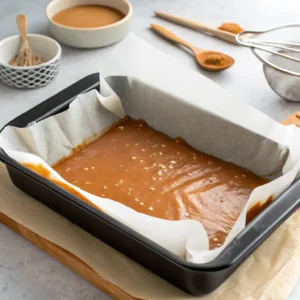
- Mix Sugar: In a medium heavy-bottomed saucepan, combine sugar, corn syrup, and water. Stir until sugar is moistened.1 cup granulated sugar, 1/2 cup light corn syrup, 1/4 cup water

- Cook Sugar: Cook mixture over medium heat without stirring until it reaches a light amber color and registers 320°F (160°C) on a candy thermometer.
- Add Cream: Remove from heat and carefully add the warmed heavy cream (mixture will bubble vigorously). Stir until smooth.1 cup heavy cream

- Cook Caramel: Return to medium-low heat and add butter pieces. Stir continuously until mixture reaches 245-248°F (118-120°C) for firm but chewy caramels.5 tablespoons unsalted butter
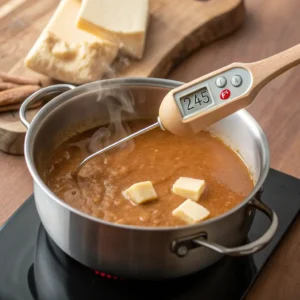
- Add Flavoring: Remove from heat and stir in vanilla extract and salt until incorporated.
- Set Caramel: Pour caramel into the prepared pan and let cool completely at room temperature for about 3 hours, or refrigerate for 1 hour until firm.
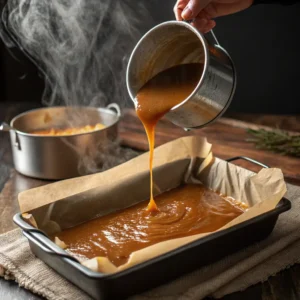
- Cut Caramels: Once firm, use parchment paper overhang to lift caramel from pan. Cut into 36 equal pieces (6 rows by 6 columns) with a sharp knife. If the knife sticks, lightly oil the blade.
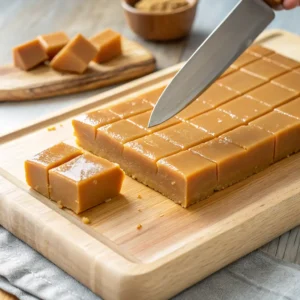
- Chill Caramels: Place cut caramels on a parchment-lined baking sheet and freeze for 15 minutes to firm up before dipping.
- Melt Chocolate: While caramels are chilling, melt chocolate and coconut oil in a heatproof bowl set over simmering water (or in microwave in 30-second intervals), stirring until smooth.12 ounces good-quality dark chocolate, 1 tablespoon coconut oil or neutral vegetable oil

- Dip Caramels: Using a fork or dipping tool, dip each caramel piece into the melted chocolate, allowing excess to drip off. Place on parchment paper.
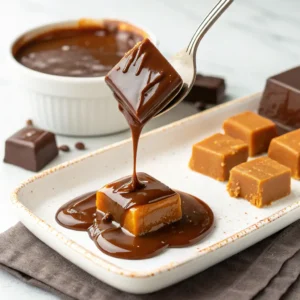
- Add Salt: Before chocolate sets, sprinkle each piece with a few flakes of sea salt.
- Set Chocolate: Allow chocolate to set completely at room temperature (about 1 hour) or refrigerate for 15-20 minutes until firm.
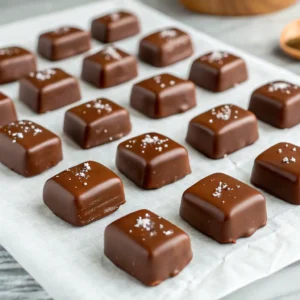
Notes
- For softer caramels, cook to 240°F (115°C) instead.
- Store in an airtight container at room temperature for up to 2 weeks, or refrigerate for up to 1 month.
- Place pieces in mini cupcake liners for gift-giving.
- Try variations with different chocolate types, add cinnamon or espresso powder to the caramel, or sprinkle with chopped nuts instead of salt.
- Work quickly when dipping as caramels soften at room temperature.
Did you love this recipe? Rate it and share your experience!
There are no reviews yet. Be the first one to write one.

